Yang J., Nanni L. (eds.) State of the Art in Biometrics
Подождите немного. Документ загружается.

13
Design Approach to Improve Kansei Quality
Based on Kansei Engineering
Nam-Gyu Kang
Future University Hakodate,
Japan
1. Introduction
In recent years, design has improved with development of manufacturing techniques. Only
products that satisfy the consumer survive. Karino [1] has suggested the 3 types of quality
based on relationship with physical fulfillment and individual satisfaction of designed
objects; 1) Must-be quality, 2) One-dimensional quality, such as usability and operability and
3) Attractive quality, such as pleasantness, preference. Attractive quality is especially related
to the user’s potential needs because it is deeply related with the user’s Kansei (emotional)
satisfaction. Furthermore, Noman [2] has suggested 3 levels in design; visceral, behavioral,
and reflective design engaging the appearance, efficiency and satisfaction (personal,
memories etc) respectively.
Against this background, many approaches based on Kansei engineering have been
conducted in Japan with the aim of offering more likeable designs. However, Kansei
engineering does not have a long history. In a 1986 lecture at the University of Michigan the
president of Mazda Motor Corporation introduced Professor Nagamachi’s car design process
based on Kansei engineering. In the design process, perceptions of users’ were analyzed
statistically. Kansei engineering has since then been used worldwide leading to the
development of the Japan Society of Kansei Engineering (JSKE). JSKE quantifies various
characteristics of design to meet vast individual needs. In 2007 the Japanese Ministry of
Economy accepted a ‘Declaration for creating Kansei Value’ as a national declaration further
boosting public interest in Kansei quality [3]. These foregoing highlights the importance of
Kansei quality in the future design. Clarifying the role and potential of Kansei engineering in
design is crucial to the development of Kansei quality. Using Kansei engineering case studies
this paper examines the role and potential of Kansei and Kansei quality.
2. Kansei and Ksei quality
The word Kansei has been used variously by researchers in relation not only to design but
also to other research fields. It is therefore imperative to define Kansei, Kansei quality and
subsequently, to address the relationship between the two in relation to the design process.
2.1 What is Kansei in design?
According to the Japanese dictionary, origin of Kansei is a German philosopher
“Sinnlichkeit” of Kant. Elsewhere Kansei is interpreted as “the ability of sense”, “the power
of intuition” and “Sensibility”.
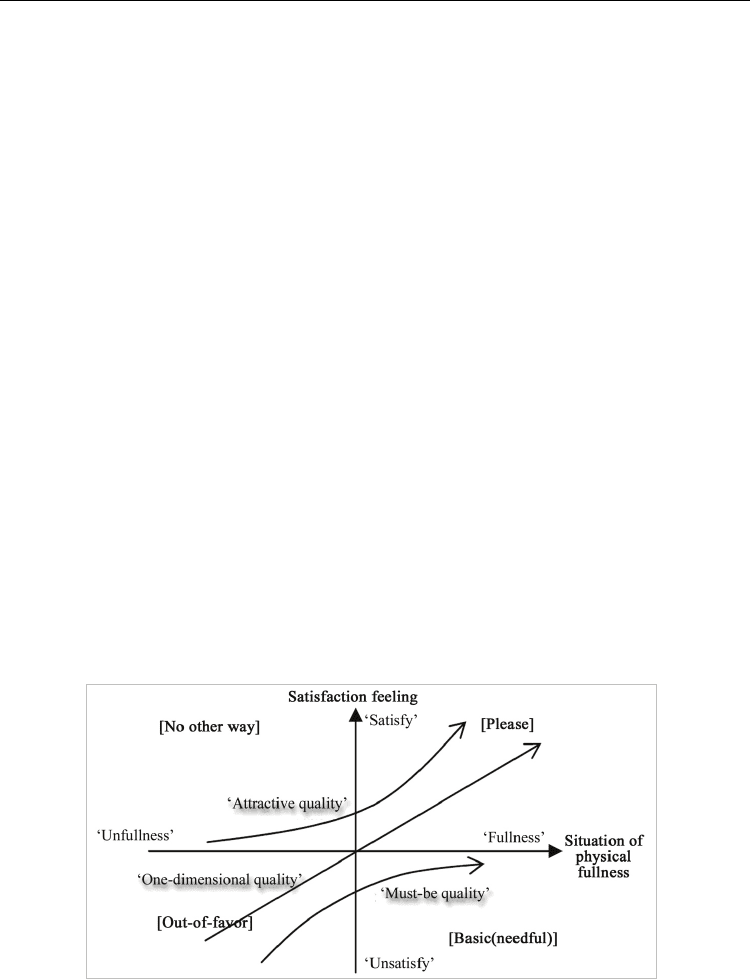
State of the Art in Biometrics
250
According to many Kansei researches, Kansei is different from Chisei (This word is Japanese
meaning intelligent), which works to increase knowledge or understanding by verbal
description of logical facts also [4]. Kansei and Chisei are processed by the mind when
information is received from the external world. Tsuji also refers to Kansei as the opposite of
Chisei [5]. Harada [6] goes further to list three major characteristics of Kansei as; 1) human
expression based on added knowledge and experience to inborn dispositions; 2) the ability
to react to and evaluate external stimuli intuitively; and 3) the interaction of intuition and
intelligent activity. P. Levy [7] defines Kansei as ‘an internal process (or function) of the
brain, involved in the construction of intuitive reaction to external stimuli’. For purposes of
this paper therefore Kansei is defined as “the intuitive reaction to external stimuli based on
one’s past experiences”.
In design, Kansei is understood as the important action of the heart to express imagery.
Kansei works to evaluate an ambiguous feeling and impression of intuitive facts. The A
design created through a designers’ Kansei becomes a stimulus which the user
psychologically evaluates. The designer must therefore understand his/her own Kansei as
well as the user’s Kansei.
2.2 What is Kansei quality in design?
As I have described previously, there are 3 types of qualities, Must-be quality, One-
dimentional qulity and Attractive quality, in the designed object (Fig.1). Even if anyone
evaluates the Must-be quality or One-dimentional, the evaluation results of those are almost
same because those qualities were evaluated with the basic demand or the changing
demand based on one’s conscious standard. In contrast, the evaluation results of Attractive
quality are different depend on the individual because the Attractive quality was evaluated
with the potential demand based on the one’s subconscious standard. The basic demand is
the factor what is satisfied no matter what. The changing demand is depend on change of
satisfaction level. However, the potential demand is factor to exceed the expectation of a
user. In that case, almost of the users did not expectant or didn’t even notice the potential
demand.
Fig. 1. A reflection of physical fulfillment and user satisfaction from an object
According to Shimaguchi’s research, there are extensional meaning (=dictionary meaning)
and intentional meaning (=implicative meaning) in a designed object. If anyone evaluates

Design Approach to Improve Kansei Quality Based on Kansei Engineering
251
the intentional meaning in the object, the results of evaluation are almost same. However,
the evaluation results of intentional meaning are different depend on the individual. To
synthesize the previous research, Kansei quality can be summarized as following; Kansei
quality is the intentional meaning of the object, it is evaluated intuitively with the tacit knowledge
based on the human’s past experiences. This Kansei quality was related in human’s potential
demand. If we improve Kansei quality in design, we have to understand a users’ tacit
knowledge (they don’t even notice.) based on their daily experiences.
3. Case study 1: Kansei library search system ‘MegLook’
There are several search systems in a library. However, almost of all of these systems use
keywords such as author, title or genre for searching. These systems require previous
knowledge of what is being searched for. In other words, these systems can be called Chisei
(=intelligence) dependent systems. These library search (LS) systems are very useful for
users such as adults who have previous specific knowledge about what they are searching
for. However, these systems are not helpful for children who don’t have previous specific
knowledge. Sometimes a user lacks sufficient literal or specific information about a book
they need. Moreover, in addition to keywords many library search systems re several
require multiple step processes that can be time consuming and difficult.
The purpose of this study was to propose a new Kansei LS system for children based on
behavior and to demonstrate the superiority of the Kansei LS system. The ‘Kansei system’ in
this case was defined as a system that can be operated intuitively with nothing but the tacit
knowledge gained through one’s past experiences. No special knowledge would be required
to operate the system. Moreover, in the process of operating the system users would be able
to experience positive changes of emotion such as ‘comfort’, ‘pleasantness’, ‘a desire to use
the system more’ and so on [7].
In this chapter a Kansei quality LS system developed by our research team based on
observation of child behavior is discussed.
3.1 Survey
3.1.1 Method of survey
Many researchers use human behavior as Kansei information that is rich and varied. There is
even an ‘Association for Behavior Analysis’ in Japan [8]. It is therefore feasible to meet
potential needs of users by observation of their behavior. In other words, observation of user
behavior is very important for the development of Kansei quality in design.
3.1.2 Results of survey
There are two types of LS system in Hakodate City Library; one is for adults and the other is
for children. However, if a child wants to search using the LS system for children, the child
has to input the keywords such as author, title or genre etc. Many children cannot use the LS
system without the previous specific knowledge about what they are searching for.
Actually, there were few cases in which children successfully used the LS system in without
assistance.
An analysis of behavioral patterns (Fig 2) revealed that the keyword search system was
difficult for many users, especially children. Many children searched for and selected books
based on ambiguous information such as graphical images from the front book cover, the
book spine and perceptions from looking at 3 or 4, 5 pages.
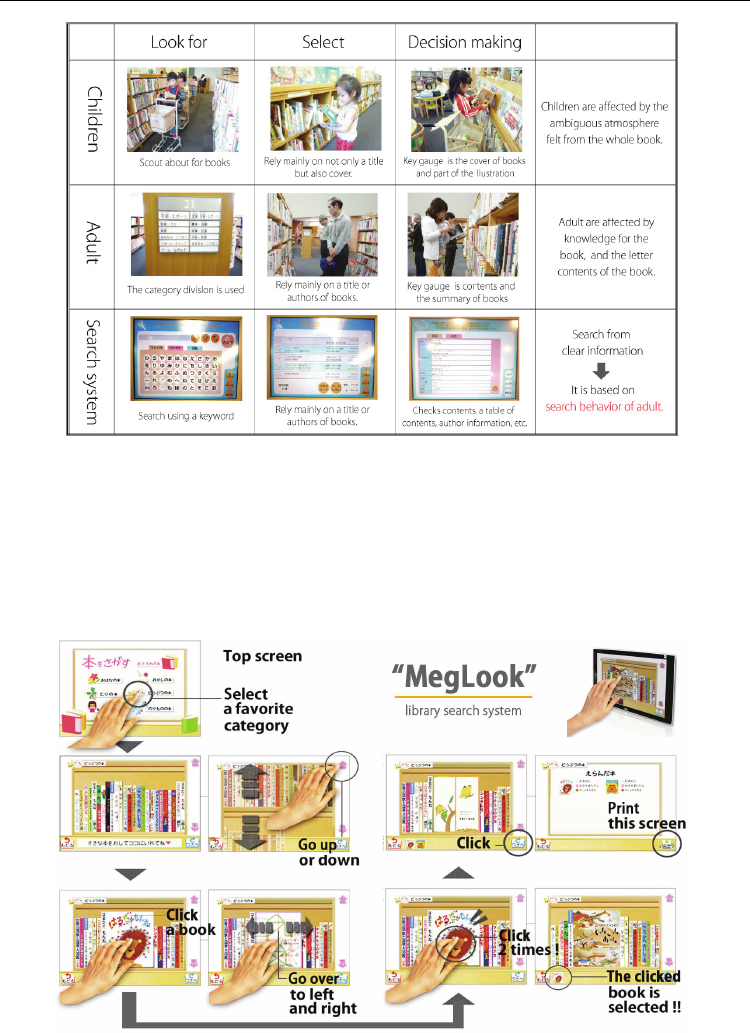
State of the Art in Biometrics
252
Fig. 2. Analysis of behavioral patterns in selection of books at Hakodate Library
3.2 Proposal of Kansei LS system ‘MegLook’
Based on these results, we proposed a new Kansei Library search system called ‘MegLook’
[9]. With the ‘MegLook’ system, users can intuitively select by simply looking at the book
spines. After making an initial selection, users can look at graphical images of the book
cover and five pages (Fig. 3). Using this information, users can decide if they like the book.
Using a touch screen, users can also save or print this information for future reference.
Fig. 3. The ‘MegLook’ Library search system based on Kansei

Design Approach to Improve Kansei Quality Based on Kansei Engineering
253
3.3 Evaluation experiment
The purpose of this experiment was to compare ‘MegLook’ with the existing LS system.
Special emphasis was given to Kansei quality of both systems.
3.3.1 Method of evaluation
Our field evaluations were conducted with two subject groups at the ‘Hakodate City Library’.
There were 20 subjects in the child group (6 boys, 14 girls, average age 9.45 years old) and 10
subjects in the adult group (the children’s parents). Subjects compared ‘MegLook’ and the
conventional LS system, using seven criteria: 1) Pleasantness (Pleasantness of experience), 2)
Easy to understand (Ease of understanding system), 3) Easy to operate (Ease to operation),
4) Friendly (User-friendliness), 5) Preference (System preference), 6) Ease with which books
could be found (Ease of search success) and 7) Wish to use the system more (User loyalty).
They also wrote comments after their evaluations. We gave the subjects only three
evaluation choices because most of them were children.
3.3.2 Results of evaluation
For each of the criteria MegLook’ was preferable to the conventional LS system (Table 2). This
was especially significant for criteria 1, 5 and 7. The results show that the subjects were more
satisfied with ‘MegLook’ than the existing LS system. The adults found Meg Look preferable
with respect to criteria 1, 4, 5 and 7. However, the ‘MegLook’ did not do well criteria 3. The
adults even found the conventional system preferable in terms of criterion 6 (Fig 3). For the
adult group, finding a book on the current LS system was rather easier. We feel this is
because they already have the specific knowledge and keywords (author, title and genre) to
know what they are looking for. Adults also do not browse the books like children do so
‘MegLook’ does not greatly enhance their search. It must also be noted that ‘MegLook’ system
was designed mainly for children thus the lower performance on criterion 6 among adults
was considered to be insignificant. The results were compared with with Karino’s 3 types
qualities; Must-be quality, One-dimensional quality and 3) Attractive quality.
‘MeguLook’ did not score highly among the adult group in One-dimensional quality such as
usability and operability, but it scored very highly in terms of Attractive quality such as
pleasantness, friendliness and preference. Results from the children’s group were however
different from the adults (Fig. 4). All seven of their evaluation scores for ‘MegLook’ were
higher than the conventional LS system. ‘MegLook’ scored very highly in the wish to use more,
preference, friendliness and pleasant categories. They also scored easy to operate and easy to find
a book higher than the existing LS system. The results prove that children can use ‘
MegLook’
without specialized knowledge on how to operate the system. Overall ‘MegLook’ was the
preferred system for both groups.
Table 2. Results of evaluation
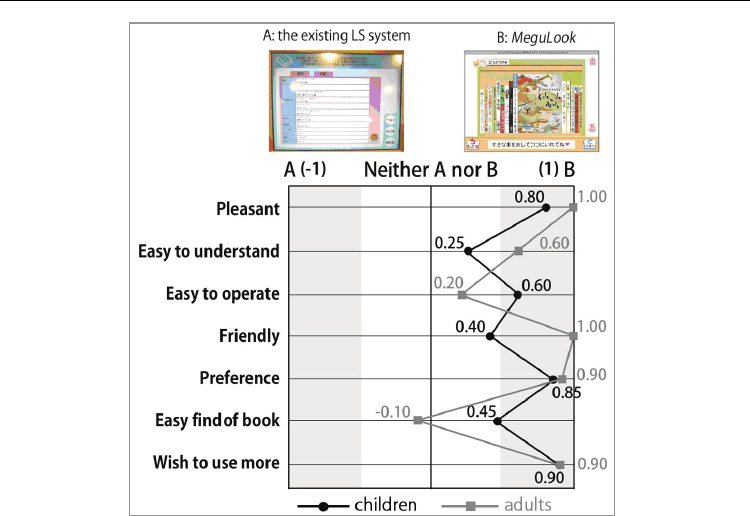
State of the Art in Biometrics
254
Fig. 4. Results of evaluation
3.4 Summary
We proposed ‘MegLook’ based on behavioral analysis of how children search for and select
books at a library. And through our field trials we proved ‘MegLook’ is superior to existing
LS systems. Since adults already have specific knowledge and are probably accustomed to
the to the conventional LS system, their preferences for ‘MegLook’ were not as high as those
for the children’s group. Even then, in terms of Attractive quality, ‘MegLook’ was preferable
for both groups. And in terms of one-dimension quality ‘MegLook’ was preferable for the
children’s group. It can be concluded that ‘MegLook’ was the preferable system that brought
the most pleasure to the search experience.
4. Case study 2: Kansei medical information system ‘mellonet’
Recently, several proposals for the development of new medical environments for elderly
patients through medical information systems (MI systems) have been made. However
users often fail to adjust to the fast pace at which information technology products evolve.
As a result many of proposed MI systems are of little use to elderly patients. Against this
background, a new MI system, named ‘mellonet’ was developed by our research team[10].
4.1 Proposal of ‘mellonet’
‘mellonet’ was proposed based on two observations; 1) usage of MI systems in a hospital by
elderly patients and 2) behavior of elderly patients using special equipment during
hospitalization. ‘mellonet’ is operated using an intuitively operated simple touch screen or a
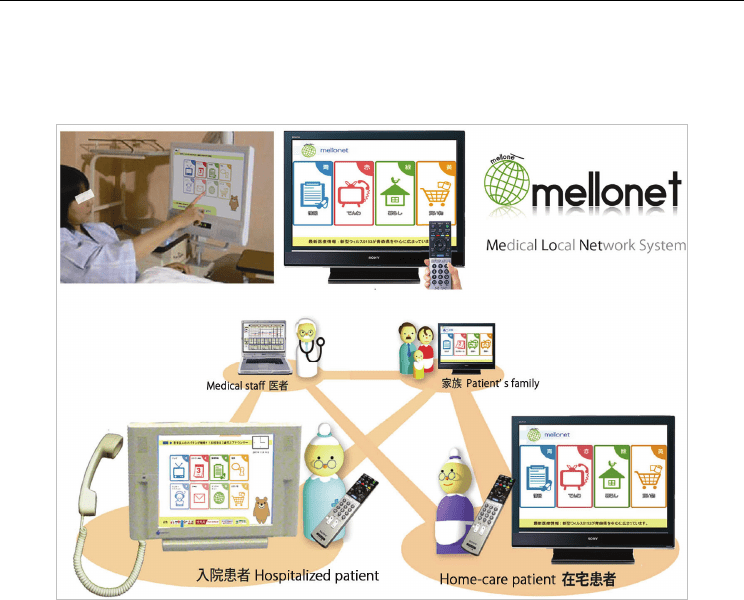
Design Approach to Improve Kansei Quality Based on Kansei Engineering
255
device similar to television remote control. Both of these tools were deemed easy for elderly
users. ‘mellonet’ helps to check patient's MI and to support communication between the
elderly patient and the his/her caregiver or the medical staff. For easy accessibility, the
system is placed at the bedside in a hospital or living room at home (Fig 5).
Fig. 5. mellonet system
4.2 Evaluation experiments
4.2.1 Method of evaluation
The purposes of this research were to visualize the characteristic of Kansei quality in our
new MI system ‘mellonet’ and to determine effectiveness of ‘mellonet’. The subject searched
for medical information with ‘mellonet’ and a conventional MI system. Two analyses were
performed; 1) familiarity with information devices as a factor of age and 2) evaluation of
Kansei quality in our new MI system ‘mellonet’ by factor analysis using the SD method. The
subjects were divided into 3 groups; 1) 20’s group (19 subjects, average age: 20.8), 2) 30’s to
40’s group (8 subjects, average age: 42.5) and 3) 50’s to 60’s group (8 subjects, average age:
59.5). Each subject selected a familiar information device such as ‘TV’, ‘internet device’,
‘cellular phone’ and ‘fixed-line phone’.
The subject then performed 15 tasks such as ‘Checking for operation schedules’, ‘Watching
the TV’, ’looking up drugs’ with ‘mellonet’ and the existing MI system (Fig. 6). To improve
reliability the order in which the systems were operated was random. Behavior of the
subjects was recorded with a video camera for protocol analysis. Finally, the subject’s
perception of each system was evaluated using the SD method based 15 criteria selected
from previous research [11] information system evaluation. A 5 level evaluation was used
for each criterion.
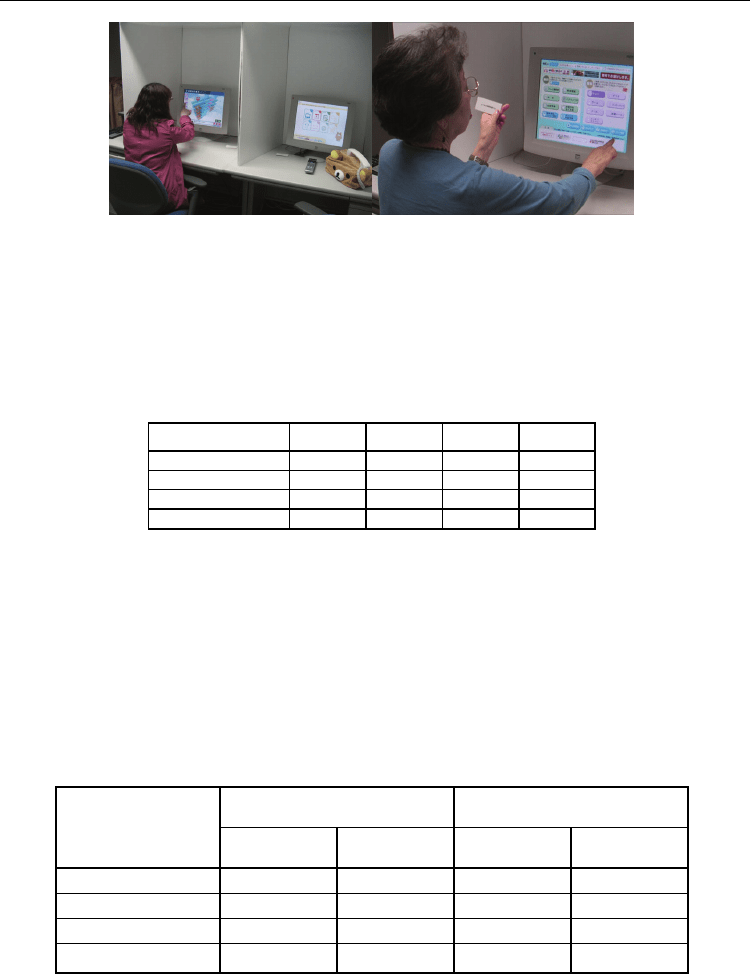
State of the Art in Biometrics
256
Fig. 6. Scenes from the experiment
4.2.2 Results of evaluation
From the survey of familiar devices, all subjects of the 50’ to 60’ group were more familiar
with ‘TV’ and ‘fixed-line phone’, and fewer were familiar with ‘internet device’. On the
other hand, all subjects of the 20’ group were more familiar with ‘internet device’ and
‘cellular phone’. Table 3 shows these results. From these results it was TV and TV remote
control in were selected for use in ‘mellonet’.
20's 30's-40's 50's-60's Average
Television 84.2 100.0 100.0 94.7
Internet device 100.0 75.0 37.5 70.8
Cellular phone 100.0 75.0 62.5 79.2
Fixed-line telephone 15.8 100.0 100.0 71.9
Table 3. Adoption rate by age (Familiar device as a factor of age of subjects)
On behavior of subjects, protocol analysis revealed that average time for completion of
tasks with the conventional MI increased with advancing age (F (2.32) =19.00, p< 0.01)
(Table 4). However with ‘mellonet’ average completion time per taks was shortened and
there were no significant differences between age groups. Similarly the average number
errors in operation increased with advancing age (F (2.32) =14.88, p< 0.01) when subjects
used the conventional MI. However with ‘mellonet’ there were fewer errors and no
significant differences between age groups in the number of errors. The results indicate that
even elderly patients can use ‘mellonet’ intuitively without the special knowledge on how to
operate the system.
the exisitng
MI system
mellonet'
MI system
the exisitng
MI system
mellonet'
MI system
20's 20.73 14.48 0.67 0.03
30's to 40's 28.53 16.22 1.75 0.25
50's to 60's 34.99 19.63 2.5 0.00
Variance analysis
F(2.32)=19.00, p<0.01
n.s
F(2.32)=14.88, p<0.01
n.s
Average time for one operation
(sec.)
Average number of times
of error in operation
Subject
Table 4. Average taken time per task and average number of errors in operation
On the subject’s perception of each system using SD method, ‘mellonet’ was evaluated higher
than the conventional MI system on most of the criteria (Figure 7). Significant differences
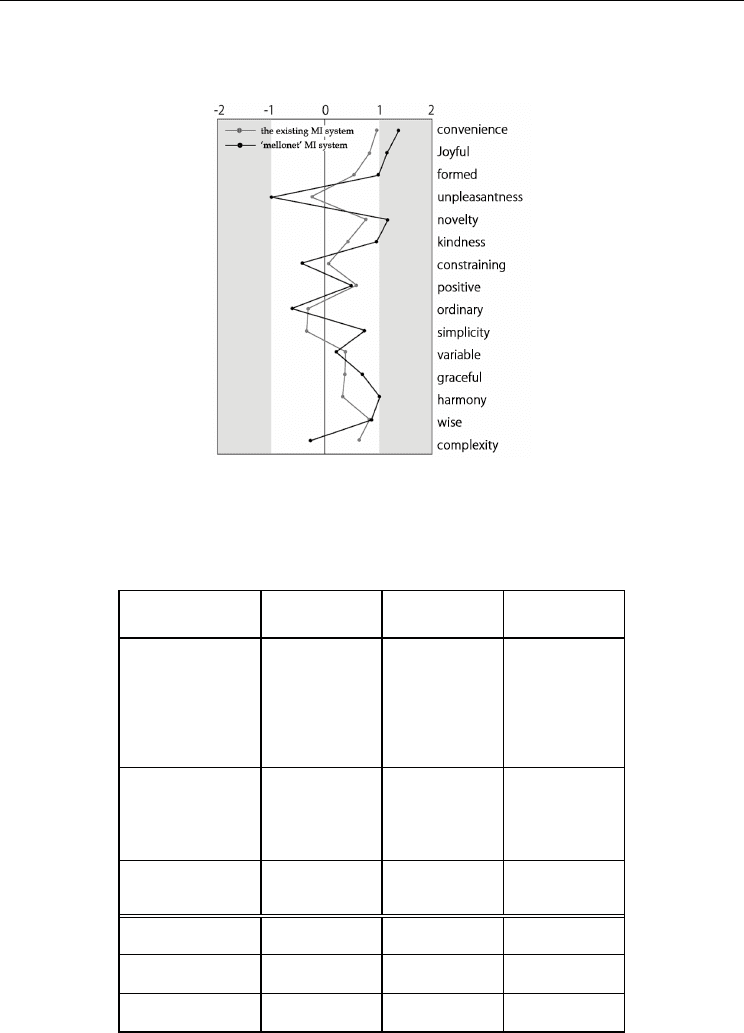
Design Approach to Improve Kansei Quality Based on Kansei Engineering
257
between subject perceptions of the two systems were observed for 8 criteria including
convenience, unpleasantness, kindness, constraining, simplicity, gracefulness, harmony and
complexity.
Fig. 7. Result of SD method
We conducted factor analysis using results from SD method. Table 5 shows the result of
factor analysis. As a result of factor analysis, we could extract the 3 factors as comprehensive
impression of both systems (table 5).
Factor 1: Factor 2: Factor 3:
Friendliness Innovativeness Sophisticatication
simplicity -0.832 0.325 0.250
difficult 0.734 -0.144 -0.034
free -0.526 -0.232 0.069
unpleasantness -0.542 -0.287 -0.206
convenience 0.510 0.198 0.233
kindness 0.491 0.004 0.321
formed 0.480 -0.191 0.427
original 0.021 -0.779 -0.037
variable 0.063 0.777 -0.486
positive -0.153 0.667 0.160
novelty 0.090 0.551 0.072
joyful 0.377 0.434 0.213
awkward 0.013 -0.051 0.671
wise -0.004 0.297 0.581
harmony 0.425 -0.118 0.444
Eigenvalues 3.987 2.976 3.698
Variance explained (%) 31.714 17.191 3.624
Cummulative variance
explained (%)
31.714 48.905 52.529
Variable
Table 5. Results of factor analysis

State of the Art in Biometrics
258
The 3 factors analyzed were ‘Friendliness’, ‘Innovativeness’ and ‘Sophistication’ (table 5).
The Figure 8 shows the scores of each factor for the two systems. These results show that
many subjects, including the elderly, could operate the ‘mellonet’ more quickly and easily
than the conventional system. Moreover failure rate while using ‘mellonet’ was lower than
that while using the existing MI system. SD method results also showed that scores of
"friendliness" and "refinement" were higher for the ‘mellonet’ system. Moreover on analysis
of the friendliness and sophistication factors shows that ‘mellonet’ is significantly more
friendly than the conventional system.
-0.476
0.033
0.204
-0.033
-0.204
0.476
-0.6
-0.3
0
0.3
0.6
Friendliness Innovativeness Sophisticatication
the existing
system
‘mellonet’
Fig. 8. Result of factor score of both systems.
4.3 Summary
From the results, we confirmed mellonet's effectiveness and superiority as a Kansei MI
System enabling even operation by elderly users through gained tacit knowledge based on
daily experiences and without need for special knowledge. In other worlds, friendly
characteristic of system is an indication of its Kansei quality.
5. Case study 3: Kansei photo browser system ‘KanSya’
Everyone has moving experiences resulting from stimuli such as movies, novels and so on.
Such moving experiences can be described as Kansei (intuitive reaction to external stimuli
based on one’s past experiences). If we apply Kansei to photo browser system (PBS) design
process, more users can have moving experiences. However, with the advent of digital
photography and the resultant sheer volume of photographic data, browsing for a particular
photograph can be difficult. One solution has been to add tags to the photos [4-6]. However,
most tagging systems are based on the people in the photos, the places or dates.
Unfortunately, such tagging methods do not allow Kansei based searches.
Therefore, this research focused on the construction of a PBS, with special attention paid to
the emotive impressions from the photos. We propose creating emotags (emotive + tags) in
addition to the tags already in use.
